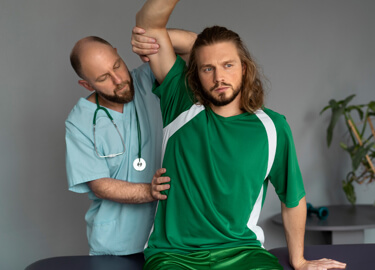Locations

The Importance of Physical Therapy for Athletes

The Importance of Physical Therapy for Athletes
Athletes, from professionals to emerging youth athletes, are prone to injuries due to the high demands placed on their bodies. These injuries not only affect their physical well-being but also have an emotional and mental impact. Physical therapy plays a crucial role in the rehabilitation process, helping athletes recover from injuries and preventing further damage. However, physical therapy is not limited to injury recovery; it is an essential component of a well-designed training program to optimize sports performance and prevent injuries. In this comprehensive guide, we will explore the various benefits of physical therapy for athletes and how it can improve their overall performance.
Section 1: The Role of Physical Therapy in Injury Prevention
Subsection 1.1: Assessing Weaknesses and Improving Flexibility
To prevent injuries, athletes must address weaknesses and improve their flexibility. Physical therapists use specific screening methods to assess an athlete's current physical condition, including joint range of motion, muscle strength, balance, coordination, flexibility, and pain. Based on the assessment, a tailored exercise program is developed to target each area of weakness. By addressing these weaknesses and improving flexibility, athletes can reduce the risk of injuries and enhance their overall performance.
Subsection 1.2: Correcting Form for Optimal Efficiency
Form is crucial in any sport. Poor form can negatively impact speed, strength, endurance, and power. Physical therapists are trained to assess an athlete's form and provide guidance on how to adjust it for maximum efficiency. By correcting form, athletes can optimize their movements, minimize energy wastage, and reduce the risk of injuries.
Section 2: Enhancing Performance Through Physical Therapy
Subsection 2.1: Improving Range of Motion and Neuromuscular Control
Physical therapy plays a vital role in improving an athlete's range of motion and neuromuscular control. By working with an advanced physical therapist, athletes can push their joints to their limits without experiencing pain, resistance, or apprehension. This helps to enhance their range of motion, enabling them to perform at their best during competitions and training sessions.
Subsection 2.2: Enhancing Technique and Muscle Balancing
Proper technique is crucial for athletes to maximize their performance and minimize the risk of injuries. Physical therapists focus on teaching athletes the correct positioning and movement techniques to optimize loading of the appropriate tissues and conserve energy. Additionally, physical therapists help athletes balance their muscle groups to avoid overworking certain muscles, which can lead to imbalances and potential injuries.
Subsection 2.3: Developing Power, Strength, and Speed
Depending on the specific sport, athletes require different combinations of power, strength, and speed. Physical therapists work with athletes to develop tailored exercise programs that challenge their muscles and improve their power, strength, and speed. By progressively increasing weights, sets, and repetitions, athletes can build muscle strength and size. Additionally, physical therapists incorporate exercises that focus on generating and controlling rotational forces, which are essential for many sports.
Section 3: The Emotional and Mental Benefits of Physical Therapy
Subsection 3.1: Addressing Emotional Responses to Injuries
Injuries can have a significant emotional impact on athletes. They may feel frustrated, depressed, or fear that they may not be able to return to their sport at the same level. Physical therapists understand the emotional toll of injuries and provide support to athletes throughout the recovery process. They help athletes find ways to stay positive, regain their confidence, and maintain a sense of identity even during the rehabilitation phase.
Subsection 3.2: Reducing Physiologic and Mental Stress
Physical therapy goes beyond exercise and strengthening muscles. It also involves techniques such as massage therapy to release muscle tension and activate the body's relaxation response. These techniques help athletes combat both physical and mental stress, promoting overall well-being and enhancing their ability to perform at their best.
Section 4: Returning Stronger After an Injury
Subsection 4.1: Retraining the Body and Addressing Contributing Factors
Despite taking precautions, injuries can still occur. When athletes experience injuries, physical therapy becomes crucial in their journey to recovery. Physical therapists develop targeted exercise programs to retrain the body and address factors that contributed to the injury, such as balance, weakness, or overuse. This comprehensive approach not only helps athletes recover but also reduces the likelihood of future injuries.
Subsection 4.2: Setting Realistic Goals and Monitoring Progress
During the rehabilitation process, physical therapists work closely with athletes to set realistic goals and monitor their progress. They provide guidance and support, helping athletes stay focused and motivated throughout their recovery journey. By setting achievable milestones, athletes can track their progress and celebrate small victories, ultimately returning stronger than before.
Physical therapy is a vital component of an athlete's journey towards optimal performance and injury prevention. By addressing weaknesses, improving flexibility, correcting form, and enhancing technique, physical therapy helps athletes perform at their best. Additionally, physical therapy provides emotional and mental support, reducing stress and facilitating a positive mindset during the recovery process. Whether athletes are recovering from an injury or aiming to enhance their performance, physical therapy is a valuable tool that empowers them to reach their full potential. Contact a physical therapist today to unlock your athletic potential and achieve your goals.



